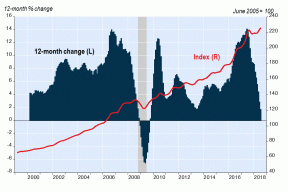In July the Teranet–National Bank National Composite House Price IndexTM was up 0.8% from the previous month.[1] As in June, the gain might seem large but was below the historical average for the month (1.0% for July). If the index were purged from seasonal variations, the so-called “seasonally adjusted” index would have retreated in June and would have been flat in July.
As in May and June, prices were up in 10 of the 11 metropolitan markets surveyed, led by Ottawa-Gatineau (2.3%), Winnipeg (1.9%), Montreal (1.3%), Halifax (1.2%) and Hamilton (1.1%). For Toronto the index rise matched the countrywide average of 0.8%. The index was also up for Edmonton (0.7%), Quebec City (0.6%), Vancouver (0.4%) and Victoria (0.4%). The index for Calgary was flat.
The published (non-seasonally-adjusted) Toronto index rose for a fourth straight month in July. In contrast, the seasonally adjusted index would have declined for a fourth straight month. This means that the recent monthly rises in the published index reflected only seasonal pressures instead of an underlying trend. The retreat of the seasonally adjusted index over this period was due to non-condo housing[2] (−2.1%); the seasonally adjusted condo subindex was up 1.6%. These numbers are consistent with market conditions, tighter for condos than for other housing. The monthly rise of the Vancouver and Victoria indexes has slowed markedly since last September. Seasonally adjusted, both indexes would have been down in July for a second consecutive month. The index for Montreal stands out for its advance in 17 of the 19 months since January 2017, a showing equalled only by Vancouver.
Teranet-National Bank National Composite House Price Index™
In July the composite index was up 1.8% from a year earlier, the smallest 12-month rise since July 2013 and a 13th consecutive deceleration from the record gain of 14.2% during the year ending June 2017. The main contributor to the slowdown was Toronto, the largest metropolitan market, down 4.0% from a year earlier, followed by Hamilton (−1.5%) and Calgary (−0.1%). There were small 12-month rises in Edmonton (0.3%) and Quebec City (0.6%) and rises exceeding the countrywide average in Winnipeg (2.5%), Montreal (4.0%), Ottawa-Gatineau (5.1%), Halifax (5.5%), Victoria (6.8%) and Vancouver (10.6%).
Besides the Toronto and Hamilton indexes included in the composite index, indexes exist for the seven other urban areas of the Golden Horseshoe. In July, two of these (Barrie and Oshawa) were, like Toronto and Hamilton, below their peaks of Q3 2017. Indexes not included in the composite index also exist for seven markets outside the Golden Horseshoe, five of them in Ontario and two in BC. The 12-month rise of these indexes varied widely, from 2.4% for Thunder Bay to 17.6% for Abbotsford-Mission.
Click here for the full report including historical data.



Recent Comments